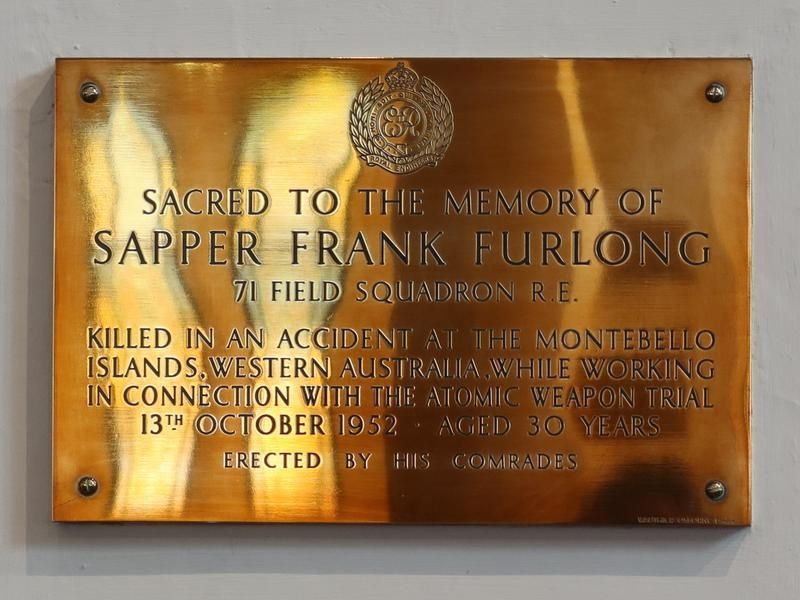
Gillingham
St Barbara’s Garrison Church, Maxwell Road, Gillingham, Rochester Upon Medway, Kent, ME7 5SG
What 3 Words ///epic.woods.quite
The plaque has the following inscription;
SACRED TO THE MEMORY OF SAPPER FRANK FURLONG 71 FIELD SQUADRON R.E.
KILLED IN AN ACCIDENT AT THE MONTEBELLO ISLANDS, WESTERN AUSTRALIA, WHILE WORKING IN CONNECTION WITH THE ATOMIC WEAPON TRIAL 13TH OCTOBER 1952. AGED 30 YEARS
ERECTED BY HIS COMRADES

This is not a BNTVA plaque but a memorial for Sapper Frank Furlong who died. We've included an article about Peter Fletcher, ex-BNTVA Chairman, who served with Frank Furlong during Operation Hurricane. Peter speaks of flying back out to the Montebello Islands and holding a memorial service at Frank's graveside in Australia. Peter also led the campaign for the plaque to be placed at Gillingham
Peter Fletcher
Reader’s Story by Ron Knight
I first met Peter Fletcher an Ex Chepstow boy soldier in 1951when like so many regular and National servicemen we formed 71 Fld Squadron in Abergavenny South Wales.
This Squadron was to be (although at the time we didn’t know it) the guinea pigs for the first Atomic bomb test on a remote set of desolate Islands off the North West coast of Western Australia.
The Monte Bello Islands. Forever etched in my memory.
On returning to England, we were sent to Kingshill Camp in Hoo St Werburgh on the Isle of Grain. But not for long as we were all split up and went to different units and scattered to the four winds.
I didn’t meet up with Peter again until September 1986 when he came out to Perth WA with Frank Gray, both were involved in the BNTVA and they wanted to visit Monte Bello Islands, Woomera and Maralinga all within ten days.
It dawned on them that Australia is a vast country and to get to Onslow north west of Perth was a five day drive then a boat trip to MB.
Due to time constraints we held a commemoration service at the War Memorial in Kings Park overlooking the beautiful Swan River. Wreathes were laid for all people who had perished in the nuclear holocaust of past conflicts, for the Aboriginal nations that had suffered the effects of radiation and told of the dire consequences.
It was in 1987 that Peter as a representative of the BNTVA arrived on my doorstep on October 1st with plane tickets to Karratha in the north and a trip to Barrow Island then onto Monte Bello on the 3rd October for the first commemorative at the Islands.
All this due to Peter’s persistence and patience organising the trip, going back after so long had a profound effect on both of us and we said we must make it back to Monte B again, this happened in 1991 Peter and a friend Chris Rowlands arrived on the last day of September and again Pete had arranged everything with WAPET OIL who ran Barrow Island.
They flew out of Perth on the 2nd October and were in and on the Monte Bello Islands (by Chopper courtesy of Bell Helicopters contracted to WAPET) at 8.30am to once again hold a service in remembrance of the 39th anniversary of the first test and then fly to Onslow for a dedication service at the graveside of Spr Frank Furlong who died on October 13th 1952.
Peter had fought and won funds from the British Legion to maintain the grave for ten years. It was to be the last time I was to see Peter in Australia.
Having taken on the Chairmanship of BNTVA he worked hard and long for the cause and the association and we corresponded regularly.
Peter’s health was failing but he never gave up fighting for the cause to better the lives of our members who have suffered so much from the ravages of nuclear radiation.
It was in 1996 that I met Peter for the last time at his home in St Helens. I was shocked at his frailty as his body slowly and painfully succumbed to his sickness. He asked for my word and a promise that I would go back to the Monte Bello Islands again.
This was solemnly given and I made it back to the Islands for the 50th anniversary and at 8.30am on October 3rd I stepped ashore with the British Standard.
Afterwards, I phoned Peter to let him know we had done it. Peter Fletcher was a tireless hard working man, as he saw the awful effects that radiation did to the human body and committed himself to trying to right the wrongs done to us, the serviceman who through no fault of their own were sent into radiated areas without a thought for them by the government.
There are many others who also worked as hard but this is my story about Peter Fletcher, Soldier, boxer, loyal friend who never gave up the fight for others.
Ron Knight Perth, Western Australia
March 21st 2012
Office 25 Derwentwater Avenue, Acklam, Middlesbrough TS5 7DB
Email
office@bntva.com
Office
25 Derwentwater Avenue,
Acklam, Middlesbrough TS5 7DB
Email
office@bntva.com
All Rights Reserved | British Nuclear Test Veterans Association (BNTVA)
